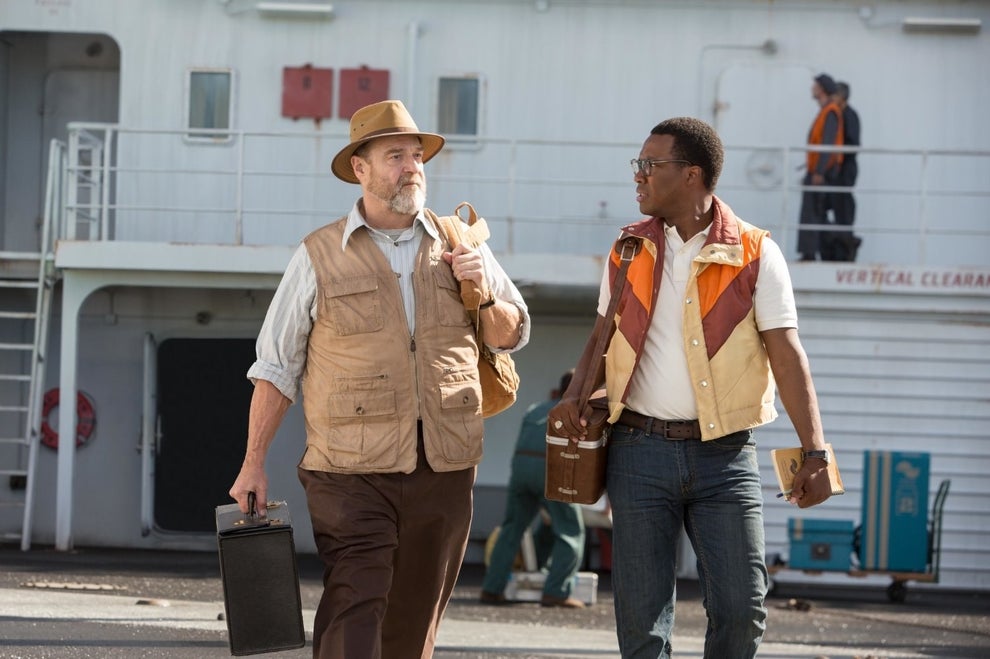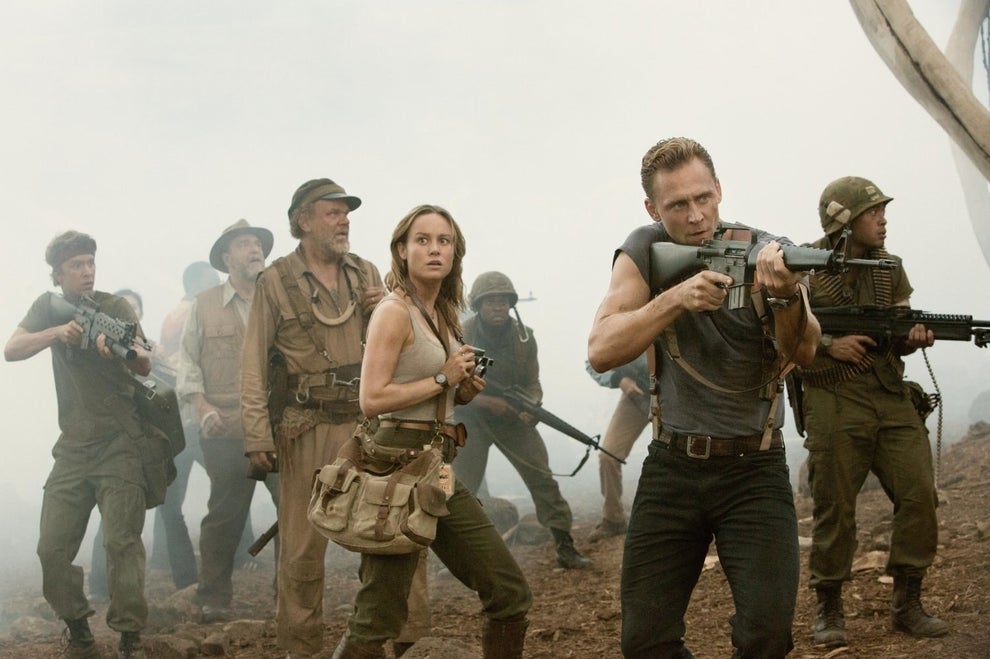
The most interesting things about Kong: Skull Island are what it chooses to leave out— its female lead defined by the degree to which she’s no longer a damsel, its monster by how much he’s no longer a veiled figure of xenophobic dread. Kong: Skull Island deals with a story that’s beyond familiar — it’s the iconic one of the big screen’s biggest ape, first seen in silvery black and white in 1933, last played by a motion-captured Andy Serkis in Peter Jackson’s 2005 revamp, with other iterations in between.
Kong is one of those creations so woven into the fabric of pop culture that people who haven’t seen any of the movies he’s been featured in over the past 84 years still have a sense of what happens in them. His story is very famous and, from a contemporary perspective, fraught, replete with enough retrograde and racist elements that Kong: Skull Island ends up inventing whole swaths of new narrative to fill in the gaps and create something that, despite being set in the 1970s, feels contemporary.
Bill Randa (John Goodman) and Houston Brooks (Corey Hawkins) in Kong: Skull Island. Chuck Zlotnick / Warner Bros.
King Kong is at its core a fable about Otherness, something the new movie, directed by The Kings of Summer’s Jordan Vogt-Roberts, struggles to reckon with. The characters in the original film blithely set forth for territory uncharted by Westerners, an actual “there be monsters” location whose inhabitants are portrayed as a collection of primitive, human-sacrificing stereotypes. They, like their simian god, are entranced by whiteness, offering to trade six local women for the “golden” Ann Darrow (a character, played in the original film by Fay Wray, who’s brought on the trip by a documentarian “because the public, bless ‘em, must have a pretty face to look at”).
And Kong himself is a veiled figure of racist dread, an outsized projection of fears about black physicality and sexuality, a long history of simian slurs made literal. He’s an example of what film professor and historian Ed Guerrero referred to as “cinematic eruptions of socially repressed forces of sexuality that carry the threat of a dreaded primordial ‘blackness.’” He’s treated as an exotic, titillating spectacle to be put on stage for a formalwear-clad audience in a phantasmagoric parody of a slave auction — until he proves uncontrollable, loosing himself on white civilization and white women, at which point he’s put down.
Kong: Skull Island isn’t a particularly good movie, but it is a markedly conscientious one, aware of the baggage that needed to be shed from its source material while not entirely sure what to do in its place. It does try to have its giant ape be just a giant ape — fighting the rapacious lizard-like predators that one character nicknames “Skullcrawlers,” mourning his even more massive dead parents (the Kong family boneyard makes for a choice backdrop for a showdown), and bonding in a carefully lustless way with photojournalist Mason Weaver (Brie Larson) over a shared recognition of the other’s compassion and desire to keep peace.
Mason Weaver (Brie Larson) and James Conrad (Tom Hiddleston) in Kong: Skull Island. Chuck Zlotnick / Warner Bros.
But even in a movie in which humans turn out to be — duh-dun! — the real monsters, it’s also still humans who guide us into the story and provide the point of view. Kong: Skull Island swaps out perpetual damsel Ann for Mason, a capable if not all that developed photojournalist. It gratifyingly delegates objectification duties to Tom Hiddleston, who plays hunter-tracker-whatever James Conrad, sleeves creeping further and further up his toned biceps as the movie goes on. And it steers itself toward some disappointingly half-baked references to Apocalypse Now in an aim for greater thematic weight, its shell-shocked soldiers trading the jungles of Vietnam for those of Skull Island, with Samuel L. Jackson’s Lieutenant Colonel Preston Packard as a kind of insta-Kurtz who’s gone wild-eyed and unstable from being too long at war.
Kong: Skull Island is a prequel of sorts to Gareth Edwards’ 2014 film Godzilla, following in the swimming-pool-sized footsteps of a movie that treated its homo sapiens like unavoidable but distasteful obstacles on the way toward hot kaiju action. But the new movie actually has more in common with Denis Villeneuve’s Arrival, an alien drama that’s significantly better, but that similarly pivots on a female character battling through a sea of testosterone and actually attempting to connect.
Arrival is also a fable about Otherness, its tentacled extraterrestrials different not only in their form and in their language, but in the very way they experience time. It is also a story about communication, an anti-action movie in which the tension comes not from fight scenes but from whether fighting could be avoided. Louise Banks (Amy Adams) is alone in a room (and, it seems, on a globe) led by men whose first instinct when faced with something powerful and unknown is to assume it’s a threat. In her attempt to prove otherwise, Louise desperately charts out a grammar and vocabulary so foreign it actually requires her to change herself, to become a little less human in order to comprehend it.
Kong: Skull Island is very much pro-action — Kong is introduced swatting down helicopters like flies for reasons that are later revealed to be reasonable, the first of several set pieces. But, like Arrival, it also affirms that empathy is the opposite of war, that the urge to go to battle in some ways requires a willful refusal to understand the other party. Kong: Skull Island starts off during World War II with the crash landing of two pilots, one American and one Japanese, who continue to attempt to murder each other until something more alarming comes along, and who, we learn later, eventually become friends. It’s a lesson that Mason, the war photographer — or, per her regrettable preference, “ANTI-war photographer” — never needs to learn: She, like Louise, is a professional communicator, though she traffics in images rather than words.
It’s a shortcut, casting women as figures for whom empathy comes more naturally, and not an entirely fair one — women can’t and shouldn’t be excused from being shoot-first aggressors. But these movies also have commonalities with children’s fare like E.T. the Extra-Terrestrial and The Iron Giant, in which kids are the ones who bond with otherworldly characters, in defiance of government and military forces who react with defensiveness and hostility. It’s not gendered critique these films are making, it’s one of authority that happens to still be relentlessly tied into patriarchy, one of us-against-them certainty.
Preston Packard (Samuel L. Jackson) in Kong: Skull Island. Chuck Zlotnick / Warner Bros.
“The world is bigger than this!” Mason retorts in Kong: Skull Island when Packard insists, “We’re soldiers, we do the dirty work so that families back home don’t suffer! They shouldn’t even know that a thing like this exists!” He cuts her off with a very Jackson-y “Bitch, please.” Over eight decades, the figure of Kong has progressed from racist projection to, in subsequent remakes, a more overtly tragic but doomed figure, to, finally, a full-on hero. But at that moment, the Ann figure feels like she’s changed just as seismically — like she’d happily be snatched up in a giant hand and spirited away into the jungle, because a monster would be better company than these men.




